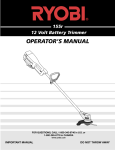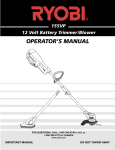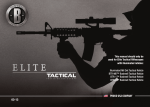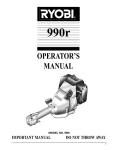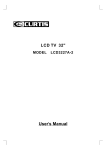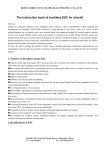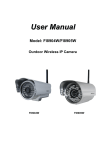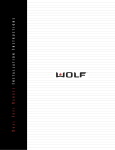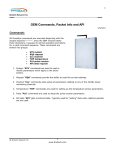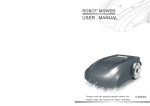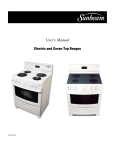Download warning - Power equipment parts and accessories from Outdoor
Transcript
MODEL 140r CORDLESS TRIMMER OPERATOR'S MANUAL WARNING Never operate the trimmer without the string guard installed. If the unit is operated without the string guard in place, you will void the warranty. IMPORTANT MANUAL DO NOT THROW AWAY 1 INTRODUCTION THANK YOU CONTENTS I. Thank you for purchasing this quality product. This modern power tool has been designed to provide many hours of useful service. You will find it to be a great labor-saving device. This manual has been prepared to provide you with common sense operating instructions and to ensure that you will get maximum satisfaction. To keep your unit in top operating condition, use the maintenance and service procedures in this manual. II. III. PRODUCT REFERENCES, ILLUSTRATIONS AND SPECIFICATIONS All information, illustrations and specifications in this manual are based on the latest product information available at the time of printing. We reserve the right to make changes at any time without notice. Copyright © 1993 Ryobi Outdoor Products, Inc. All Rights Reserved. Bump Knob™ and Monoflail® are trademarks of Ryobi Outdoor Products, Inc. Battery Door IV. V. VI. VII. VIII. Safety Warnings ......................................................3-4 A. Pre-Operational Safety Warnings ..........................3 B. Battery Safety Warnings ........................................3 C. Charger Safety Warnings........................................3 D. Operational Safety Warnings ..................................4 E. Other Safety Warnings ............................................4 Assembly Instructions..............................................5-7 A. Assembling and Mounting the Wall Station ..........5 B.. Installing the D-Handle ..........................................5 C. Installing the String Guard ......................................6 D. Charging Instructions ..........................................6-7 E. Removing the Battery ............................................7 F. Battery Disposal ......................................................7 Operating Instructions..............................................8-9 A. Starting/Stopping the Trimmer................................8 B. Holding the Trimmer ..............................................8 C. Adjusting the Trimming Line Length ......................8 D. Decorative Trimming ..............................................9 E. Tips for Best Trimming Results ..............................9 Maintenance and Repair Instructions ....................9-11 A. Installing a New Trimming Line..........................9-10 B. Installing a Prewound Reel ..................................11 C. Cleaning the Trimmer............................................11 D. Storage ................................................................11 Replacement Parts ....................................................11 Specifications ............................................................11 Troubleshooting ........................................................12 Warranty Statement ....................................Back page CONTENTS OF CARTON This unit should consist of the following: D-Handle Battery Housing 1. Battery housing 2. Motor assembly 3. Aluminum outer housing (boom) The cardboard insert should contain: 1. Battery charger The plastic bag should contain: Trigger 1. 2. 3. 4. 5. 6. Wall station with three screws Wall station clamp with one screw Black D-handle with one bolt, washer and wing nut String guard with two washers and screws Operator's manual Owner's registration card SERVICE INFORMATION Service on this unit both within and after the warranty period should be performed only by an authorized and approved dealer. Dial 1-800-345-8746 to obtain the listing of the authorized service dealer nearest you. String Guard Motor Assembly DO NOT RETURN THE UNIT TO THE RETAILER. THIS PRODUCT IS COVERED BY ONE OR MORE OF THE US PATENTS: 4,779,405;4,651,422;4,505,040;4,463,498; 4,223,441;2,125,668; OTHER PATENTS PENDING. 2 Bump Head BATTERY WARNINGS SAFETY WARNINGS IMPORTANT SAFETY INSTRUCTIONS — SAVE THESE INSTRUCTIONS ! THE PURPOSE OF SAFETY SYMBOLS IS TO ATTRACT YOUR ATTENTION TO POSSIBLE DANGERS. THE SAFETY SYMBOLS, AND THE EXPLANATIONS WITH THEM, DESERVE YOUR CAREFUL ATTENTION AND UNDERSTANDING. THE SAFETY WARNINGS DO NOT BY THEMSELVES ELIMINATE ANY DANGER. THE INSTRUCTIONS OR WARNINGS THEY GIVE ARE NOT SUBSTITUTES FOR PROPER ACCIDENT PREVENTION MEASURES. SYMBOL MEANING WARNING: Failure to obey a safety warning can result in injury to yourself and others. NOTE: 1. Battery units do not have to be plugged into an electrical outlet, therefore they are always in operating condition. Be aware of possible hazards when you are not using your battery unit. 2. AVOID UNINTENTIONAL STARTING—Don't carry the unit with your finger on the switch. 3. USE ONLY THE CHARGER PROVIDED WITH YOUR BATTERY UNIT. Do not substitute any other charger. Use of another charger could cause batteries to explode, causing serious injury. 4. DO NOT PLACE BATTERY UNITS OR THEIR BATTERIES NEAR FIRE OR HEAT. They may explode. 5. DO NOT CHARGE BATTERY UNIT IN DAMP OR WET LOCATIONS. 6. For optimum performance, your battery unit should be charged in a location where the temperature is more than 50° F (10° C) but less than 100° F (37° C). (See "Battery and Charging Tips for Maximum Performance" on page 4). 7. DO NOT dissassemble the battery housing. Return the unit to your authorized service dealer for service or repair. Advises you of information or instructions vital to the operation or maintenance of the equipment. CHARGER WARNINGS 1. Before using the battery charger, read all instructions and cautionary markings in this manual on the battery charger and the unit using the battery charger. WARNING Failure to obey a safety warning can result in injury to yourself or to others. Always follow the safety precautions to reduce the risk of fire, electric shock and personal injury. PRE-OPERATIONAL SAFETY WARNINGS 1. Read and understand this operator's manual carefully before using this unit. Be thoroughly familiar with the proper use of your unit. 2. Thoroughly inspect your unit for loose or damaged parts before each use. If there are any loose or damaged parts, perform the needed adjustments or repairs before starting your unit. 2. To reduce the risk of injury, charge only sealed lead acid rechargeable batteries. Other types of batteries may burst, causing personal injury and damage. 3. Do not expose charger to rain or snow. 4. To reduce the risk of damage to the charger body and cord, pull the charger body rather than the cord when disconnecting the charger. 5. Make sure the cord is located so that it will not be stepped on, tripped over, or otherwise subject to damage or stress. 6. An extension cord should not be used unless absolutely necessary. Use of improper extension cords could result in risk of fire and electric shock. If an extension cord must be used, make sure: a. The pins on the plug of the extension cord are the same number, size and shape as those of the charger. b. The extension cord is properly wired and in good electrical condition; and c. The wire size is large enough for AC ampere rating of the charger as specified below. 3. Keep all bystanders, especially children, at least 30 feet (10 m) away from the work area. 4. Carefully inspect the areas to be cut. Remove all debris that could become entangled in the string. Also remove any objects that could be thrown. AWG Size of Cord, Feet FEET 25 50 100 150 AWG 18 18 18 16 3 CHARGER WARNINGS (continued) 7. DO NOT OPERATE CHARGER WITH A DAMAGED CORD OR PLUG. If the cord or plug is damaged, replace the charger. 8. Do not operate the charger if it has received a sharp blow, been dropped, or damaged in any way. If the charger case is damaged, replace the charger. 9. Do not disassemble the charger. The charger is not serviceable; disassembly may result in a risk of electric shock or fire. 10. To reduce the risk of electric shock, unplug the charger from the outlet before attempting any maintenance or cleaning. 11. Do not use charger outdoors. OPERATIONAL SAFETY WARNINGS 1. To reduce the risk of injury to yourself and others, never operate the unit without the string guard in place. 2. Wear safety glasses or goggles at all times when operating this unit. 3. Dress properly. Do not wear loose clothing or jewelry. They can be caught in moving parts. Use rubber gloves and substantial footwear when working outdoors. 4. Keep hands, face, feet and long hair away from all moving parts. 5. Do not attempt to touch or stop the string while it is rotating. 6. Always hold the unit with both hands during operation. Keep a firm grip on both the front and rear handles or grips. 7. If you strike or become entangled with a foreign object, stop the motor immediately and check for damage. Repair any damage before further operation is attempted. Do not operate the unit with loose or damaged parts. 8. DO NOT FORCE THE UNIT—It will do the job better and with less likelihood of a risk of injury working at the rate for which it was designed. 9. Use the right tool. Do not use your unit for any job except that for which it is intended. 10. Do not overreach. Keep proper footing and balance at all times. 11. Always remain alert. To prevent injury to yourself and others, do not operate your unit if you are fatigued or on medication. 12. Do not extend the trimming line length beyond the length specified in this manual. 4 OTHER SAFETY WARNINGS 1. Keep your unit in good working condition. Only your authorized service dealer should perform any repair or maintenance procedures that are not described in this manual. 2. Use only original equipment manufacturer's replacement parts when servicing this unit. These parts are available from your authorized service dealer. The use of non-standard parts, or other accessories or attachments not designed for this unit, could result in serious injury to the user and/or damage to the unit. 3. Never use metal-reinforced line or monofilament line that is not specifically designed for use with your model. This model uses 0.06 inch (1.6 mm) monofilament line. 4. STORE UNIT INDOORS - When not in use, the unit should be stored placed on the wall station in the charging mode, which should be located in a cool, dry and high place - out of the reach of children. BATTERY AND CHARGER TIPS FOR MAXIMUM PERFORMANCE 1. Your unit should be stored and charged at temperatures between 100° F (38° C) and 50° F (10° C). 2. Batteries stored for long periods of time above 100° F (38° C) will experience reduced life. 3. Cold temperatures will not affect the life of your battery. 4. The unit should be stored on the charging station in the charging mode. 5. Temperature effects on battery charging: a) 100° F (38° C) to 50° F (10° C) - The battery will be fully charged within 24 hours. b) 50° F (10° C) to 40° F (4° C) - The battery will require up to 48 hours to reach full charge. c) Below 40° F (4° C) - The battery will not reach full charge. d) Reduced unit run time will be experienced when the battery is not fully charged. ASSEMBLY INSTRUCTIONS 2. Mount the wall station to a wall stud (Fig. 2). Secure the wall stud with the three screws provided. NOTE: Strong mounting is important because an inadequately mounted wall station could drop to the floor and cause injury or damage the trimmer. ASSEMBLING AND MOUNTING THE WALL STATION Wall Stud 1. Push the barrel connector of the charger plug into the slot of the wall station. Make sure the connector is secure and inserted correctly into the slot shown (see inset in Fig. 1). 2. Slide the clamp into the slot provided. Install screw (Fig. 1). Fig. 2 INSTALLING THE D-HANDLE 1. Push the D-handle down over the boom (Fig. 3). 2. Install and tighten the bolt, washer, and wing nut. Fig. 1 Fig. 3 5 INSTALLING THE STRING GUARD 3. Install the screws and washers with a screwdriver (Fig. 6). WARNING Never operate the trimmer without the string guard installed. If the unit is operated without the string guard in place, you will void the warranty. 1. Place the string guard onto the motor assembly. Line up the small tab with the small slot and the large tab with the large slot (Fig. 4). Small Slot Fig. 6 CHARGING INSTRUCTIONS Large Slot Small Tab 1. Make sure the wall station is fastened securely to the wall stud and the charger is plugged into the wall outlet. Large Tab 2. Insert the unit into the wall station and make sure it is firmly seated (Fig. 7). When the red light is on, the battery is being charged (Fig. 8). If the light fails to turn on, check the following: a) Fig. 4 b) c) Barrel connector has been properly installed into the wall station (see Fig. 1 on page 5). Charger has been plugged into the wall outlet. Trimmer is firmly seated in the wall station. 2. Rotate the string guard counterclockwise (to the left) until the tabs line up with the screw holes and the guard locks in place (Fig. 5). Fig. 5 6 Fig. 7 Charging Indicator Light REMOVING THE BATTERY This unit is equipped with a sealed lead acid battery. When the battery needs to be replaced, use the following procedure and refer to Fig. 10. 1. To remove the existing battery: a) b) c) d) Remove the screw with a Torx® screwdriver Lift off the battery door Pull out the battery Disconnect the wires from the battery. 2. To install the new battery: a) Fig. 8 3. Charge the unit for a minimum of 36 hours before the first use. 4. The battery should be charged for a minimum of 24 hours between each use. The trimmer's operating time and the life of the battery will be shortened if this procedure is not followed. 5. This unit is designed so that the battery cannot be overcharged. Always place the unit back on the wall station immediately after use. b) c) d) Connect the black wire to the negative terminal and the red wire to the positive terminal. Slide the battery into the slots in the housing. Be careful not to pinch the wires. Hook the back end of the battery door to the housing. The two ribs should interlock (see inset). Hold the door in place and install the screw. Door Black Wire Battery 6. The unit should be stored at temperatures between 50° F (10° C) and 100° F (37° C). Red Wire Screw 7. Batteries emit explosive gases while being charged. Do not obstruct the vents on the battery case (Fig. 9). WARNING Do not smoke while charging or operating the unit. Keep unit away from open flames. Fig. 10 WARNING • Do not incinerate or mutilate battery. Batteries contain hazardous chemicals. Dispose of properly. • Do not allow metal objects to contact the battery terminals. Metal objects can short the battery terminals and cause permanent battery damage. BATTERY DISPOSAL Fig. 9 Take the used battery to a local authorized service dealer. Do not dispose of the battery yourself. 7 OPERATING INSTRUCTIONS HOLDING THE TRIMMER 1. Hold the trimmer as shown in Figure 12. This trimmer has been designed and built to withstand normal use. It will provide many hours of service provided the following operating instructions are closely adhered to. WARNING Always wear eye, hearing, foot and body protection to reduce the risk of injury when operating this unit. STARTING / STOPPING THE TRIMMER 1. Push in the safety release switch (Fig. 11). 2. Squeeze the trigger to start the trimmer. Release the trigger to stop (Fig. 11). Fig. 12 ADJUSTING THE TRIMMING LINE LENGTH 1. Your trimmer is equipped with a Bump Head, which allows the operator to release more trimming line without stopping the motor. As the line becomes frayed or worn, additional line can be released by lightly tapping the Bump Head on the ground (Fig. 13) while operating the trimmer at high speed. 1 2 Fig. 11 WARNING Do not invert the trimmer until the cutting head has completely stopped rotating. Fig. 13 Each time the head is bumped, approximately 1 in (25.4 mm) of trimming line is released. A blade in the string guard will cut the line if excess line is released. For best results, tap the head on bare ground or hard soil. If line release is attempted in tall grass, the motor may overheat. Always keep the trimming line fully extended. Line release becomes more difficult as the cutting line becomes shorter. 8 DECORATIVE TRIMMING MAINTENANCE AND REPAIR INSTRUCTIONS 1. Decorative trimming is accomplished by removing all vegetation around trees, posts, fences, etc. Use a 30degree angle when trimming with this method (Fig. 14). INSTALLING A NEW TRIMMING LINE The trimming line may be replaced by two different methods — rewinding the existing reel or installing a convenient prewound reel. Rewinding the Existing Reel To rewind the existing reel you must: 1. 2. 3. 4. Check for the correct line size Remove the existing inner reel Wind the existing reel with the new line Reinstall the existing reel. Fig. 14 The Correct Line to Use TIPS FOR BEST TRIMMING RESULTS WARNING 1. Hold the cutting line parallel to the ground, and the cutting head will be at the correct angle. NOTE: Do not rest the Bump Head on the ground. Always use genuine Monoflail® replacement line. Do not use metal-reinforced line. 2. DO NOT FORCE THE UNIT. Allow the very tip of the line to do the cutting (especially along walls). Cutting with more than the tip will reduce cutting efficiency and may overload the motor. It is very important to use the correct size line. Line with a diameter of 0.065 inches (1.65 mm) must be used. The motor may overheat or be damaged if you use a larger line. 3. Grass over eight (8) inches (200 mm) should be cut by working from top to the bottom in small increments to avoid premature line wear or motor drag. Removing the Existing Reel 4. Whenever possible, cut to your left. When cutting to the left, the unit's cutting efficiency is improved slightly. Also, the clippings are thrown away from the operator. 1. Squeeze the tabs on the Bump Head cover and remove the cover (see inset in Fig. 15). 2. Remove the existing inner reel and spring (Fig. 15). Cover 5. Slowly move the trimmer into and out of the area being cut, maintaining the trimmer at the desired cutting height. This can be either a forward-backward or sideto-side motion. Maintain top speed for best cutting. Tab 6. Trim only when grass and weeds are dry. 7. The life of your cutting line is dependent upon following the previously stated trimming techniques, as well as what is being cut, and where the cutting is being done. For example, the line will wear faster when trimming against a foundation wall as opposed to trimming around a tree. Some line breakage will occur from: • • • • Entanglement with foreign matter Normal line fatigue Attempting to cut thick, stalky weeds in excess of the unit's capability. Forcing the line into objects such as walls or fenceposts Inner Reel / Bump Knob Spring Outer Spool Fig. 15 9 3. Check the indexing teeth on the inner reel and outer spool for wear (Fig. 16). If necessary, deburr or replace the spool and reel. 4. Use a clean cloth to clean the inner surface of the outer spool (Fig. 16). 3. Push the end of the line into one of the two holding slots (Fig. 18). NOTE: Do not wind the line past the point indicated on the inner reel. NOTE: Always clean the the inner reel and outer spool. Do not remove the bolt from the center shaft of the outer spool. Indexing Teeth Fig. 18 Reinstalling the Reel Fig. 16 Winding the Existing Reel 1. Place the spring back on the center shaft of the outer spool (See Fig. 15 on page 9). 2. Insert the end of the line through the eyelet in the outer spool (Fig. 19). 1. Take approximately 20 ft (5.1 m) of new trimming line, insert one end of the line into the hole in the inner reel (Fig. 17). 2. Wind the line, in even and tight layers, onto the reel (Fig. 17). Wind the line in the direction indicated on the inner reel. NOTE: Failure to wind the line in the direction indicated will cause the Bump Head to operate incorrectly. Fig. 19 Fig. 17 10 3. Grasp the end and pull firmly to release the line from the holding slot in the reel (Fig. 20). 4. While pushing the inner reel back into the outer spool, snap on the cover of the Bump Head. Line installation is now complete. NOTE: Make sure the tabs on the cover are snapped on completely with the slots on the Bump Head. If the cover is not installed properly, it can come apart during operation. CLEANING THE UNIT 1. Keep the air vents free of obstructions (See Fig. 9 on page 7). 2. Do not use any strong detergents on the plastic housing or the handle. They can be damaged by certain household cleaners that contain aromatic oils such as pine and lemon, and by solvents such as kerosene. Moisture can also cause a shock hazard. Wipe off any moisture with a soft cloth. STORAGE Clean the unit thoroughly before storing it. Always store the unit on the wall station, which should be located in a cool, dry, well-ventilated area, out of the reach of children. REPLACEMENT PARTS PREWOUND REEL ....................................................180292 GUARD ASSEMBLY ..................................................180408 D-HANDLE ................................................................145819 D-HANDLE HARDWARE ..........................................153523 Fig. 20 CHARGER ................................................................180409 WALL STATION..........................................................180412 INSTALLING A PREWOUND REEL 1. Follow the instructions in THE CORRECT LINE TO USE. 2. Follow the instructions in REMOVING THE EXISTING REEL. 6-VOLT BATTERY ......................................................180410 BATTERY DOOR ..................................................180411 SPECIFICATIONS 3. Follow the instructions in REINSTALLING THE REEL. BATTERY, MOTOR & CUTTING HEAD Motor ........................................6 Volts - DC Battery ......................................6 Volts - Sealed Lead Acid Outer Housing ..........................Aluminum Tube Cutting Head ............................Bump Line Releaser Trimming Line Diameter............0.065 in. (1.65 mm) Cutting Path Diameter ..............8 in. (203 mm) 11 TROUBLESHOOTING POSSIBLE CAUSE AND CHECK POSSIBLE REMEDY BATTERY WILL NOT CHARGE Barrel Connector Has Not Been Installed Properly ....................Insert the barrel connector as shown in Fig. 1 on page 5. Charger is Not Plugged into the Wall Outlet ..............................Plug charger into the wall outlet. Charger Is Not Firmly Seated in the Wall Station ......................Check the position of the unit in the wall station. MOTOR OPERATES SLOWLY OR WILL NOT OPERATE Battery Is Not Charged Charge the battery for 36 hours before the first use; 24 hours minimum between each use. Foreign Matter is Caught Between Bump Head and Motor Housing ............................................................................Remove string, plastic or other foreign matter. CUTTING HEAD WILL NOT ADVANCE LINE Cutting Head Out of Line............................................................Refill with genuine replacement cutting line. Bump Knob/Inner Reel Bound Up..............................................Replace Bump Knob/inner reel. Outer Spool Dirty ........................................................................Clean outer spool. Indexing Teeth Worn or Burred ..................................................Replace inner reel and outer spool. Line Welded ................................................................................Disassemble, remove the welded section and rewind line. Line Twisted When Refilled ........................................................Disassemble and rewind reel. Not Enough Line Exposed Push the Bump Knob until the line is extended to the edge of the guard. If the above remedies do not work, take the unit to your authorized service dealer for service or repair. Do not return the unit to the retailer. Operator's Manual Part No. 180407 Printed in U.S.A. 12 Rev. C 6/96













